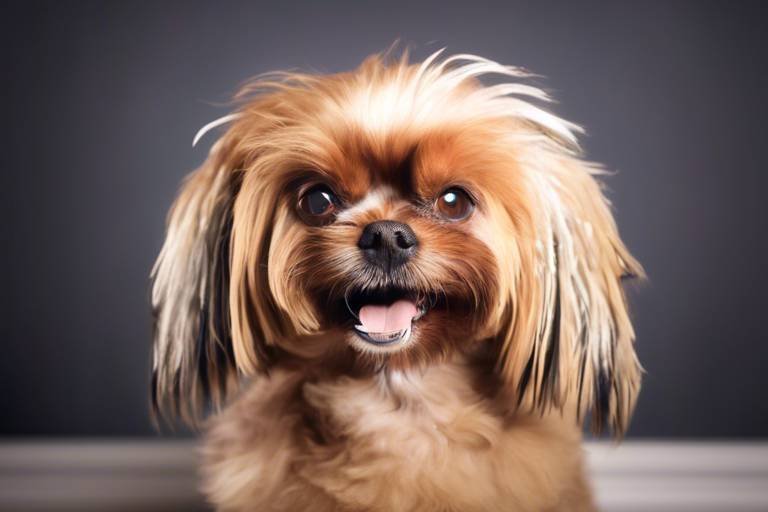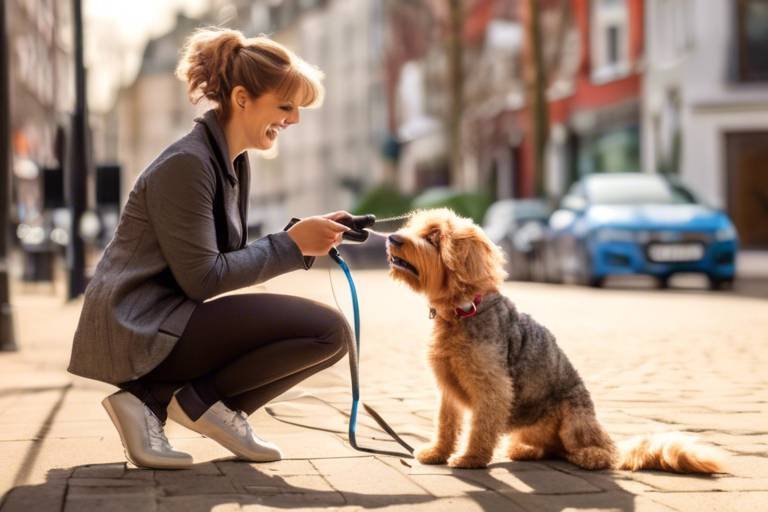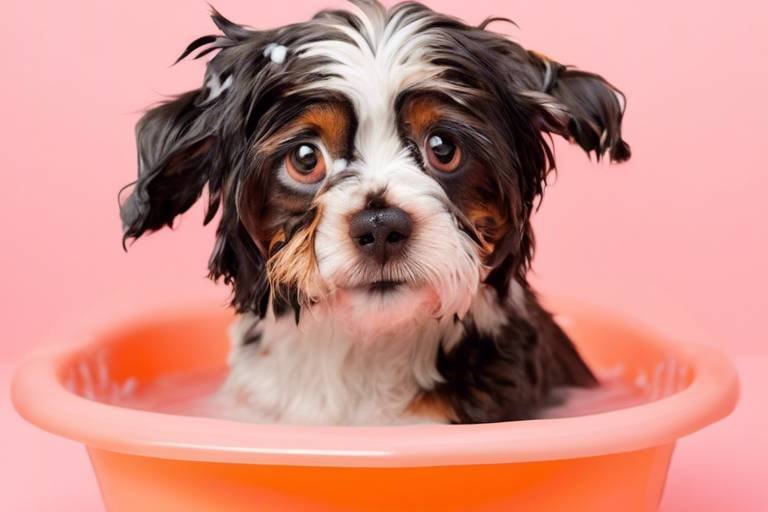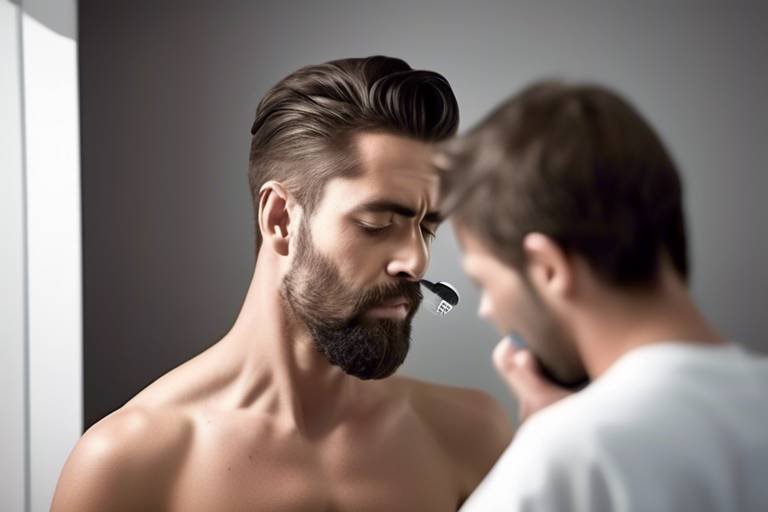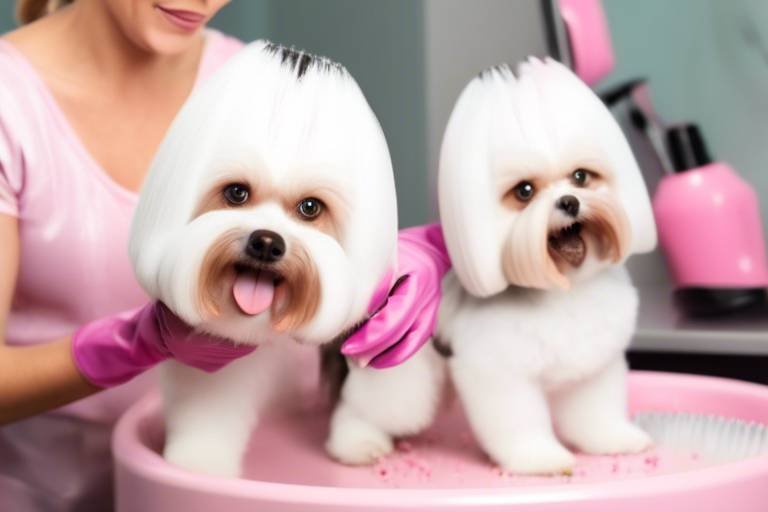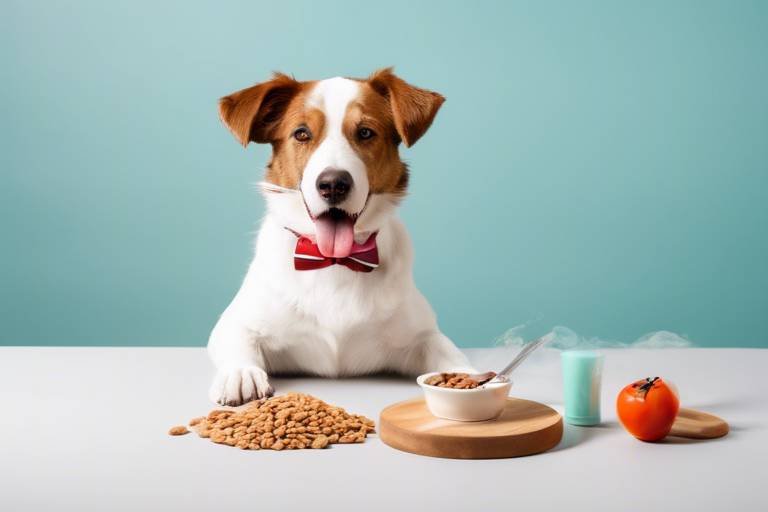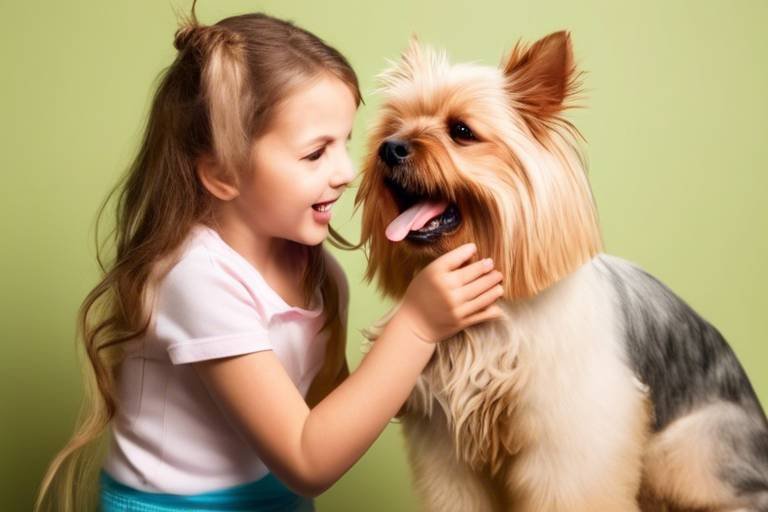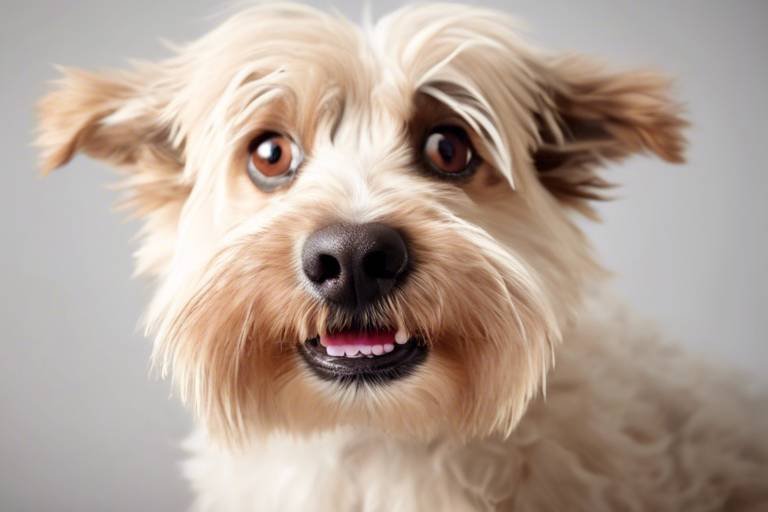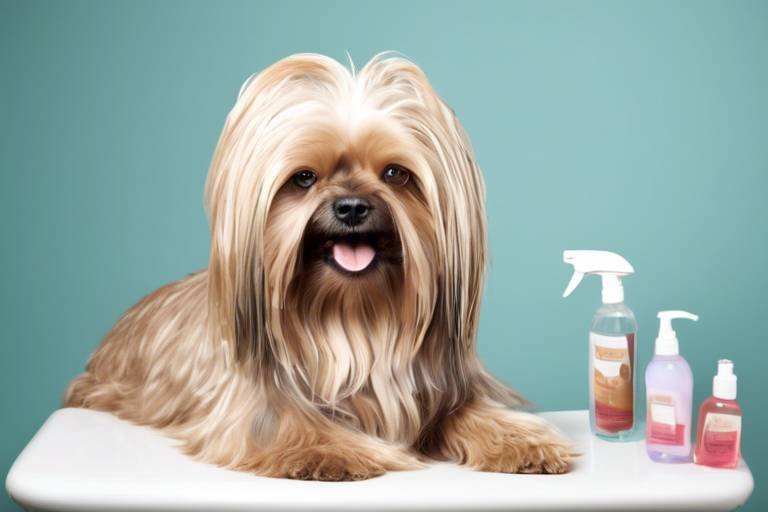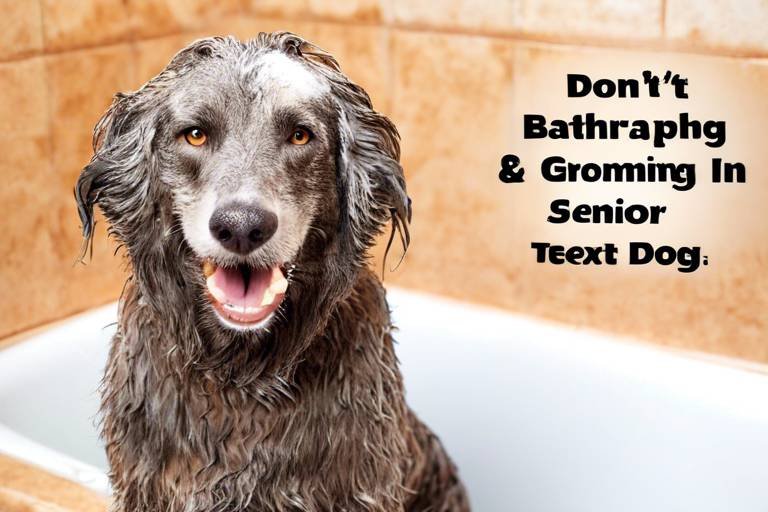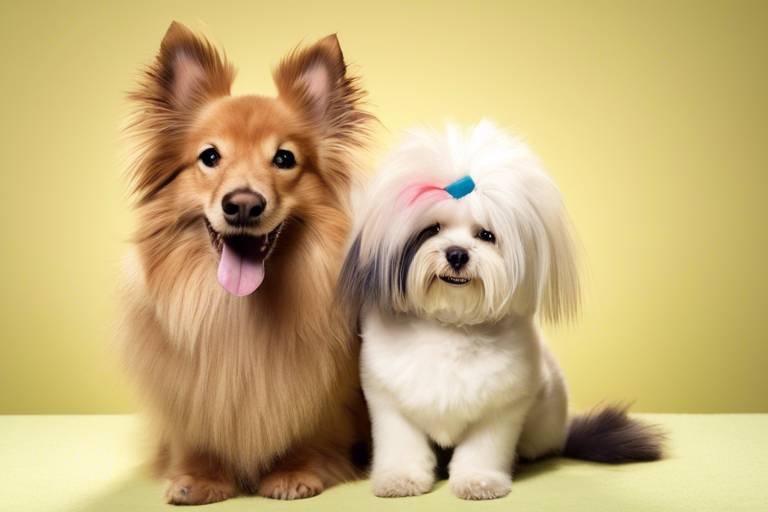How to Help Your Pet Cope with Grooming Anxiety
Grooming your pet can be a daunting task, not just for you but for your furry friend as well. Many pets experience what is known as grooming anxiety, which can turn a simple bath or trim into a stressful ordeal. Imagine being in a situation where you feel trapped, surrounded by unfamiliar sounds and smells, and unable to escape. This is how our pets often feel during grooming sessions. But fear not! There are effective strategies you can employ to help your pet feel more at ease, ensuring a smoother and more enjoyable experience. In this article, we will explore various methods to alleviate grooming anxiety in pets, allowing both you and your pet to approach grooming with confidence.
Grooming anxiety is a common issue among pets, and understanding its roots is the first step toward addressing it. Just like humans, pets can experience fear and anxiety due to various psychological and physical factors. For example, if a pet has had a negative grooming experience in the past, it may associate grooming with discomfort or pain. Additionally, certain breeds are more prone to anxiety due to their temperament or past experiences. Recognizing these factors can help owners better understand their pets' behavior and provide the necessary support.
Recognizing the signs of grooming anxiety is crucial for pet owners. By being attentive to your pet's behavior, you can intervene before their stress escalates. Common behaviors that indicate stress or fear during grooming sessions include:
- Trembling or shaking
- Hiding or trying to escape
- Excessive barking or whining
Understanding these signs helps owners address their pet's discomfort effectively during grooming. It's important to remember that each pet is unique, and their reactions may vary.
Physical manifestations of anxiety can be quite telling. For instance, if your pet is trembling or trying to hide, these are clear signs that they are feeling anxious. You might also notice them panting excessively or having a stiff body posture. Recognizing these signs allows you to take action, whether it's providing comfort or taking a break from the grooming process.
Changes in behavior, such as aggression or withdrawal, may signal grooming anxiety. If your usually friendly pet suddenly becomes aggressive or tries to escape during grooming, it's a strong indicator that they are feeling stressed. Understanding these behaviors is essential for effective pet care. It’s not just about grooming; it’s about ensuring your pet feels safe and secure.
Vocalizations like whining or growling can also indicate anxiety. If your pet is vocalizing more than usual during grooming, it’s a sign that they may be uncomfortable or scared. Different sounds can reflect a pet's emotional state, so it's essential to listen closely and respond accordingly.
Emotional indicators of anxiety, such as fearfulness or reluctance, can significantly impact grooming experiences. If your pet seems hesitant to approach grooming tools or the grooming area, it may be a sign of anxiety. Recognizing these feelings in pets is crucial for creating a positive grooming experience.
Preparation is key to reducing grooming anxiety. Taking the time to acclimate your pet to grooming environments and tools can foster a sense of safety and comfort. Start by introducing grooming tools gradually, allowing your pet to sniff and explore them without any pressure. This can help demystify the grooming process and make it feel less intimidating.
Desensitization techniques can help pets become accustomed to grooming. This involves gradually exposing your pet to the grooming process in a controlled manner. For example, you might start by brushing your pet for just a few minutes while offering treats and praise. Over time, you can increase the duration and complexity of the grooming session, helping your pet build confidence.
A positive grooming environment can significantly reduce anxiety. Consider playing soothing music and using familiar scents to create a calm atmosphere. You can also set up a comfortable space with blankets or toys that your pet loves. The goal is to make grooming a pleasant experience rather than a stressful one.
Selecting a groomer who understands pet anxiety is essential. Look for professionals who are patient and experienced in handling anxious pets. A good groomer will take the time to understand your pet's specific needs and be willing to work with you to create a positive grooming experience.
When choosing a groomer, asking the right questions can reveal their approach to anxious pets. Here are some essential questions to consider:
- How do you handle anxious pets?
- What techniques do you use to make grooming less stressful?
- Can I stay with my pet during the grooming process?
These questions can help you gauge whether a groomer is a good fit for your pet's needs.
For some pets, home grooming may be a better option. Grooming at home allows you to control the environment and pace, making it easier for your pet to feel comfortable. Start with simple tasks like brushing or nail trimming, and gradually work your way up to more complex grooming routines. Remember to reward your pet with treats and praise throughout the process to reinforce positive associations with grooming.
Q: How can I tell if my pet is anxious during grooming?
A: Look for signs such as trembling, hiding, excessive barking, or vocalizations like whining. Emotional signs like reluctance to approach grooming tools are also indicators.
Q: What should I do if my pet becomes aggressive during grooming?
A: If your pet shows aggression, it’s essential to stop grooming immediately. Take a step back, and consider working on desensitization techniques before trying again.
Q: Can I groom my pet at home instead of taking them to a professional?
A: Yes! Home grooming can be a great option for pets that experience anxiety in unfamiliar environments. Just be sure to take your time and make it a positive experience.
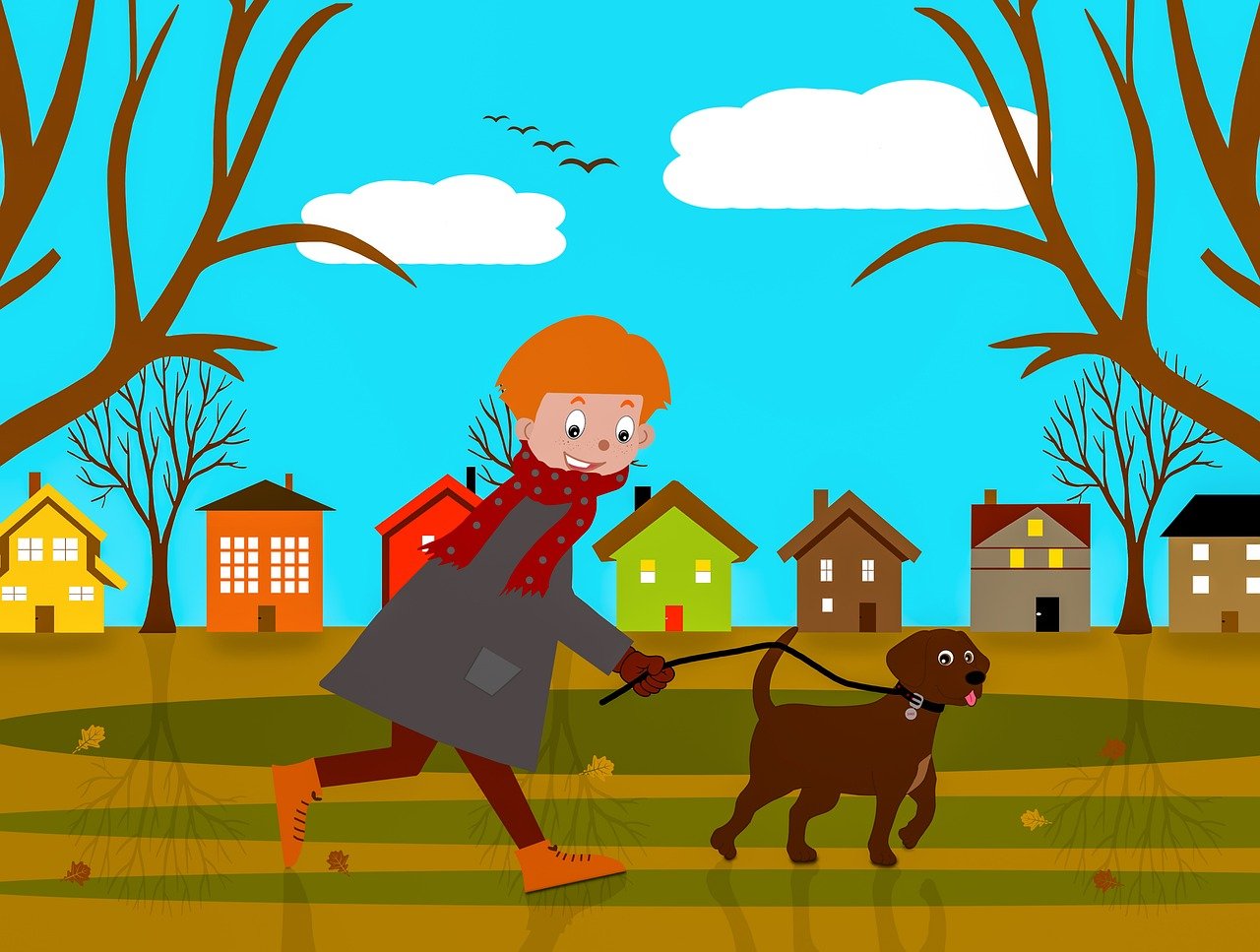
Understanding Grooming Anxiety
Grooming anxiety is a common issue that many pet owners face, and understanding its roots is essential for creating a positive grooming experience. Just like humans, pets can feel anxious about various situations, and grooming is often one of them. This anxiety can stem from several psychological and physical factors, which can lead to a range of behaviors that signal discomfort or fear. It's important to recognize that your pet's anxiety is not a reflection of their personality; rather, it is a response to their environment and past experiences.
Many pets may associate grooming with negative experiences, such as painful brushing or visits to the vet, which can create a deep-seated fear. Additionally, the sounds of clippers, the sensation of being restrained, or unfamiliar environments can heighten their anxiety. Understanding these triggers is the first step in helping your furry friend cope with grooming sessions.
Moreover, pets have varying thresholds for stress, and what might be a minor annoyance for one pet could be a significant source of anxiety for another. Therefore, it's crucial for pet owners to observe their pets closely and understand their unique reactions to grooming. By doing so, you can tailor your approach to meet your pet's specific needs.
Some common factors contributing to grooming anxiety include:
- Previous negative experiences: If a pet has had a bad grooming experience in the past, they may associate grooming with fear.
- Lack of socialization: Pets that haven't been adequately socialized may find new environments and experiences overwhelming.
- Physical discomfort: Pets with skin conditions or sensitivities may feel pain during grooming, leading to anxiety.
- Age-related issues: Older pets may experience anxiety due to declining health or cognitive function.
Recognizing the signs of grooming anxiety is crucial for pet owners. By understanding the underlying factors that contribute to this anxiety, you can take proactive steps to create a more comfortable and less stressful grooming experience for your pet. Remember, the goal is to foster a sense of safety and trust, allowing your pet to feel more at ease during grooming sessions.
Q: How can I tell if my pet is anxious during grooming?
A: Look for signs such as trembling, hiding, excessive vocalizations, or aggressive behavior. These can indicate that your pet is feeling stressed or fearful.
Q: What can I do to help my pet feel more comfortable with grooming?
A: Gradual desensitization, creating a positive environment, and choosing a groomer who understands anxious pets can significantly help.
Q: Is it better to groom my pet at home or take them to a professional?
A: It depends on your pet's comfort level. Some pets may feel safer at home, while others may benefit from the expertise of a professional groomer.
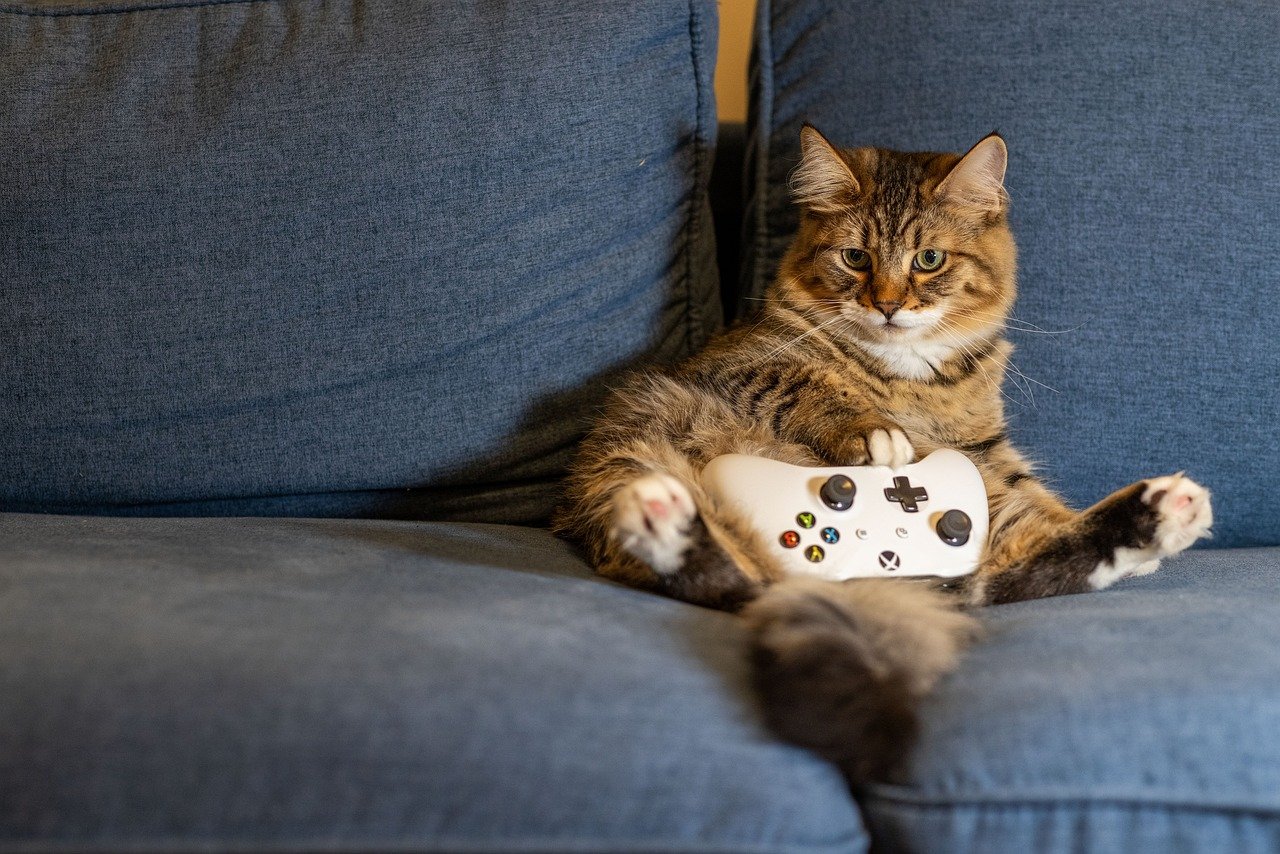
Identifying Signs of Anxiety
Recognizing the signs of grooming anxiety in your pet is crucial for ensuring their comfort and well-being. Just like humans, pets can experience stress and fear, especially when it comes to grooming sessions that involve unfamiliar tools and environments. The first step to helping your furry friend is to be aware of the various signs that indicate they may be feeling anxious or uncomfortable. These signs can manifest both physically and emotionally, and understanding them can make all the difference in creating a more positive grooming experience.
One of the most noticeable indicators of grooming anxiety is physical signs. These can include trembling, hiding, or excessive barking. For instance, if your dog is shaking or trying to escape the grooming area, it's a clear signal that they are feeling stressed. Similarly, cats may retreat to their favorite hiding spots when they sense a grooming session is about to happen. Observing these behaviors allows you to address your pet's discomfort effectively, ensuring they feel safe and secure.
Physical manifestations of anxiety can often be the first clue that something is amiss. Pets may exhibit a range of behaviors, such as:
- Trembling: Shaking or shivering can indicate fear.
- Hiding: Seeking refuge in small spaces is a common response to anxiety.
- Excessive Barking or Meowing: Vocalizations can signal distress.
Understanding these signs helps owners intervene before anxiety escalates, allowing for a smoother grooming process.
In addition to physical signs, behavioral changes can also indicate grooming anxiety. If your pet suddenly becomes aggressive or overly withdrawn during grooming, it may be a sign that they are feeling overwhelmed. For example, a dog that usually enjoys being petted may growl or snap when approached with grooming tools. Similarly, a cat that normally seeks attention might hide or swat at the brush. Recognizing these behavioral shifts is essential for effective pet care and can help you adjust your grooming techniques accordingly.
Another important aspect to consider is vocalizations. Pets often communicate their feelings through sounds. Whining, growling, or even hissing can be clear indicators of anxiety. For instance, if your dog whines when you bring out the grooming tools, it may be expressing its discomfort or fear. Paying attention to these vocal cues can provide valuable insights into your pet's emotional state, allowing you to take appropriate action to alleviate their stress.
Emotional indicators of anxiety, such as fearfulness or reluctance, can significantly impact grooming experiences. A pet that shows signs of fear, like cowering or avoiding eye contact, is likely feeling anxious about the grooming process. It's vital for pet owners to recognize these feelings, as they can lead to negative associations with grooming if not addressed properly. Creating a supportive and understanding environment during grooming sessions can help pets feel more at ease and reduce their anxiety over time.
In summary, being vigilant and observant of your pet's signs of anxiety can greatly enhance their grooming experience. By understanding the physical, behavioral, and emotional indicators of stress, you can take proactive measures to ensure your furry companion feels safe and comfortable during grooming. Remember, a calm pet makes for a calm grooming session!
Q: How can I tell if my pet is anxious during grooming?
A: Look for signs such as trembling, hiding, excessive vocalizations, or changes in behavior like aggression or withdrawal.
Q: What should I do if my pet shows signs of anxiety?
A: It's essential to address their discomfort by creating a positive grooming environment, using desensitization techniques, and possibly consulting a professional groomer who understands anxious pets.
Q: Can grooming at home help reduce my pet's anxiety?
A: Yes! Grooming at home can provide a familiar and comfortable environment for your pet, which may help alleviate their anxiety.
Physical Signs
When it comes to understanding your pet's grooming anxiety, paying attention to is crucial. These signs often manifest in ways that can be hard to miss if you're observant. For instance, if your furry friend starts to tremble or shiver at the mere sight of grooming tools, it's a clear indication of their discomfort. Similarly, you might notice your pet hiding behind furniture or trying to escape the room when it's time for grooming. Such behaviors are not just quirks; they are genuine expressions of fear and anxiety that need to be addressed promptly.
Another common physical manifestation of grooming anxiety is excessive barking. While barking is a natural behavior for dogs, if it escalates during grooming sessions, it could signify that your pet is feeling overwhelmed. In some cases, pets may also exhibit signs of hyperactivity, such as pacing or jumping around, which can be a frantic attempt to escape the situation that they find distressing.
Understanding these signs is essential for pet owners who want to create a more positive grooming experience. It's important to remember that every pet is unique, and their reactions may vary. For example, some pets may respond to anxiety by becoming aggressive, while others might withdraw completely. Being aware of these differences can help you tailor your approach to meet your pet's specific needs.
| Physical Sign | Possible Interpretation |
|---|---|
| Trembling | Fear or extreme discomfort |
| Hiding | Desire to escape the situation |
| Excessive Barking | Overwhelm or stress |
| Hyperactivity | Frantic attempt to evade grooming |
| Withdrawal | Desire to avoid interaction |
By recognizing these physical signs, you can take the necessary steps to help your pet feel more at ease during grooming sessions. Whether it's through gradual desensitization or creating a comforting environment, understanding your pet's body language is the first step toward a stress-free grooming experience.
- What should I do if my pet shows signs of anxiety during grooming?
If your pet displays anxiety, consider taking a break and allowing them to calm down. Gradual desensitization techniques can also help. - How can I tell if my pet is really anxious or just being playful?
Look for signs such as trembling, hiding, or excessive vocalizations. Playful behavior is usually more energetic and less frantic. - Is it better to groom my pet at home or take them to a professional?
It depends on your pet's comfort level. Some pets are more relaxed at home, while others may benefit from the expertise of a professional groomer. - Can grooming anxiety be eliminated completely?
While it may not be possible to eliminate anxiety entirely, with patience and the right techniques, you can significantly reduce it.
Behavioral Changes
When it comes to grooming anxiety, in your pet can serve as crucial indicators of their emotional state. If your furry friend suddenly becomes aggressive or withdrawn during grooming sessions, it's essential to recognize these signs as a form of communication. Pets, much like humans, can express their discomfort in various ways, and understanding these changes can help you provide the support they need.
For instance, if your dog, who usually loves to play and be around people, starts to hide under the couch or tries to escape the moment the grooming tools come out, this is a clear sign of distress. Similarly, a cat that typically purrs and cuddles may suddenly swat at your hand or hiss when you approach with a brush. These reactions are not just typical pet antics; they are profound signals that something is amiss during the grooming process.
It's also important to observe any sudden shifts in behavior outside of grooming sessions. If your pet starts to show signs of anxiety, such as increased aggression towards other pets or people, or even changes in their eating habits, these could be linked to their negative experiences with grooming. Such behavioral changes might include:
- Aggression: Growling, snapping, or biting can indicate that your pet feels threatened or anxious during grooming.
- Withdrawal: Hiding or seeking solitude is a common response to stress, showing that your pet wants to escape the situation.
- Restlessness: Pacing or excessive fidgeting may suggest that your pet is uncomfortable and unable to relax.
Addressing these behavioral changes is crucial for creating a more positive grooming experience. If you notice that your pet exhibits signs of anxiety, it may be beneficial to reassess your grooming approach. Perhaps consider breaking down the grooming process into smaller, more manageable sessions, or even rewarding your pet with treats and praise during and after grooming to create a more positive association with the experience.
Ultimately, being aware of these behavioral changes can help you take proactive steps to support your pet. By understanding their fears and anxieties, you can tailor your grooming methods to better suit their needs, ensuring that they feel safe and secure throughout the process.
Q: How can I tell if my pet is anxious during grooming?
A: Look for signs such as trembling, hiding, excessive vocalizations, or aggression. If your pet is trying to escape or is unusually still, these can also be indicators of anxiety.
Q: What should I do if my pet shows aggression during grooming?
A: It's best to stop the grooming session immediately and try to identify the cause of the aggression. Consider consulting a professional groomer or a veterinarian for advice tailored to your pet's specific needs.
Q: Are there specific grooming techniques that can help reduce anxiety?
A: Yes! Techniques like desensitization, using calming music, and providing treats can help ease your pet into the grooming process. Gradual exposure to grooming tools can also be beneficial.
Q: Should I consider professional grooming services for my anxious pet?
A: If your pet struggles significantly with grooming, finding a groomer experienced with anxious animals can make a big difference. They will have techniques to help soothe your pet during the grooming process.
Vocalizations
When it comes to understanding your pet's emotional state during grooming sessions, vocalizations play a crucial role. Just like humans express their feelings through words, pets communicate their anxiety or discomfort through sounds. Have you ever noticed your furry friend whining softly or growling when the clippers come out? These sounds are not just random noises; they are your pet's way of saying, "I'm not comfortable!"
Vocalizations can vary widely among different pets. Some may express their anxiety through low growls or barks, while others might resort to high-pitched whines or yelps. Understanding these sounds can help you gauge your pet's emotional state. For instance, a low growl might indicate irritation or discomfort, while a high-pitched whine could suggest fear or distress. Each vocalization can provide valuable insight into how your pet is feeling at that moment.
To help you better understand these vocalizations, consider the following common sounds and their potential meanings:
| Vocalization | Possible Meaning |
|---|---|
| Whining | Fear or discomfort |
| Growling | Warning or irritation |
| Barking | Alertness or anxiety |
| Yelping | Pain or sudden fear |
It's essential to listen closely to your pet's vocalizations during grooming. If you notice a change in their usual sounds, it may indicate that something is wrong. For example, if your dog typically remains calm but suddenly starts whining or growling, it could be a sign that they are feeling overwhelmed. In such cases, it's important to pause the grooming session and assess the situation. Perhaps they need a break or a gentle reassessment of the tools being used.
Moreover, creating a soothing environment can help minimize these vocalizations. Consider playing calming music or using soft, reassuring tones when speaking to your pet during grooming. Your voice can be a powerful tool in reassuring them that everything is okay. Remember, your pet looks to you for guidance, and your calm demeanor can help ease their anxiety.
In summary, paying attention to your pet's vocalizations during grooming is vital. These sounds are not just background noise; they are meaningful expressions of your pet's feelings. By understanding what these vocalizations signify, you can take proactive steps to ensure a more comfortable grooming experience for your beloved companion.
- What should I do if my pet is vocalizing excessively during grooming?
It's best to stop the grooming session and assess your pet's comfort level. Consider taking a break or using desensitization techniques. - Can vocalizations indicate pain during grooming?
Yes, if your pet is yelping or whimpering, it may indicate pain. Always check for any injuries or discomfort. - How can I help my pet feel more comfortable during grooming?
Creating a calm environment, using positive reinforcement, and gradually introducing grooming tools can help ease anxiety.
Emotional Signs
When it comes to understanding our furry friends, one of the most crucial aspects to consider is their emotional state, especially during grooming sessions. Emotional signs of anxiety can manifest in various ways, and recognizing these signs is vital for ensuring a comfortable grooming experience. Pets, like humans, can experience a range of emotions, and their feelings about grooming can significantly impact how they react to it.
One of the most telling emotional signs is fearfulness. If your pet seems hesitant to approach grooming tools or the grooming area, it might be a strong indicator that they associate these elements with discomfort or stress. Imagine how you would feel if you were suddenly confronted with a situation you found frightening; your pet feels similarly. This fear can lead to avoidance behaviors, where your pet might try to hide or escape when grooming time rolls around.
Another emotional sign to watch for is reluctance. If your pet exhibits signs of reluctance, such as dragging their feet or refusing to enter the grooming room, it’s a clear signal that they are not comfortable. This can be compounded by past negative experiences, which can create a cycle of anxiety that’s hard to break. Just like a child who has had a bad experience at the dentist may dread future visits, pets can carry their past grooming experiences into the present.
Additionally, you might notice your pet displaying signs of stress through their body language. A dog that tucks its tail between its legs or a cat that flattens its ears back are both expressing discomfort. These physical manifestations are often accompanied by emotional distress, creating a perfect storm of anxiety during grooming sessions. Understanding these signs can empower you to take action before the situation escalates.
To help you identify these emotional signs better, consider the following common indicators:
- Hiding: Seeking refuge under furniture or in a corner.
- Excessive licking: This can be a self-soothing behavior when they're feeling anxious.
- Yawning or panting: These can be signs of stress, even in a calm environment.
Recognizing these emotional signs is just the first step. Once you identify that your pet is feeling anxious, you can implement strategies to help them feel more secure and relaxed during grooming. Remember, your pet relies on you to advocate for their comfort and well-being. By paying attention to their emotional cues, you can create a grooming experience that is not only bearable but enjoyable.
Q: What should I do if my pet shows signs of anxiety during grooming?
A: If your pet shows signs of anxiety, try to create a calm environment. Use gentle, reassuring voices, and consider taking breaks during the grooming process. Gradually introduce grooming tools to help them get used to the experience.
Q: Can I train my pet to be more comfortable with grooming?
A: Yes! Training your pet using desensitization techniques can help. Start with short grooming sessions, gradually increasing the duration as your pet becomes more comfortable.
Q: Should I consider professional grooming for an anxious pet?
A: If home grooming proves too stressful, finding a professional groomer who understands pet anxiety can be beneficial. Look for groomers with experience in handling anxious animals.
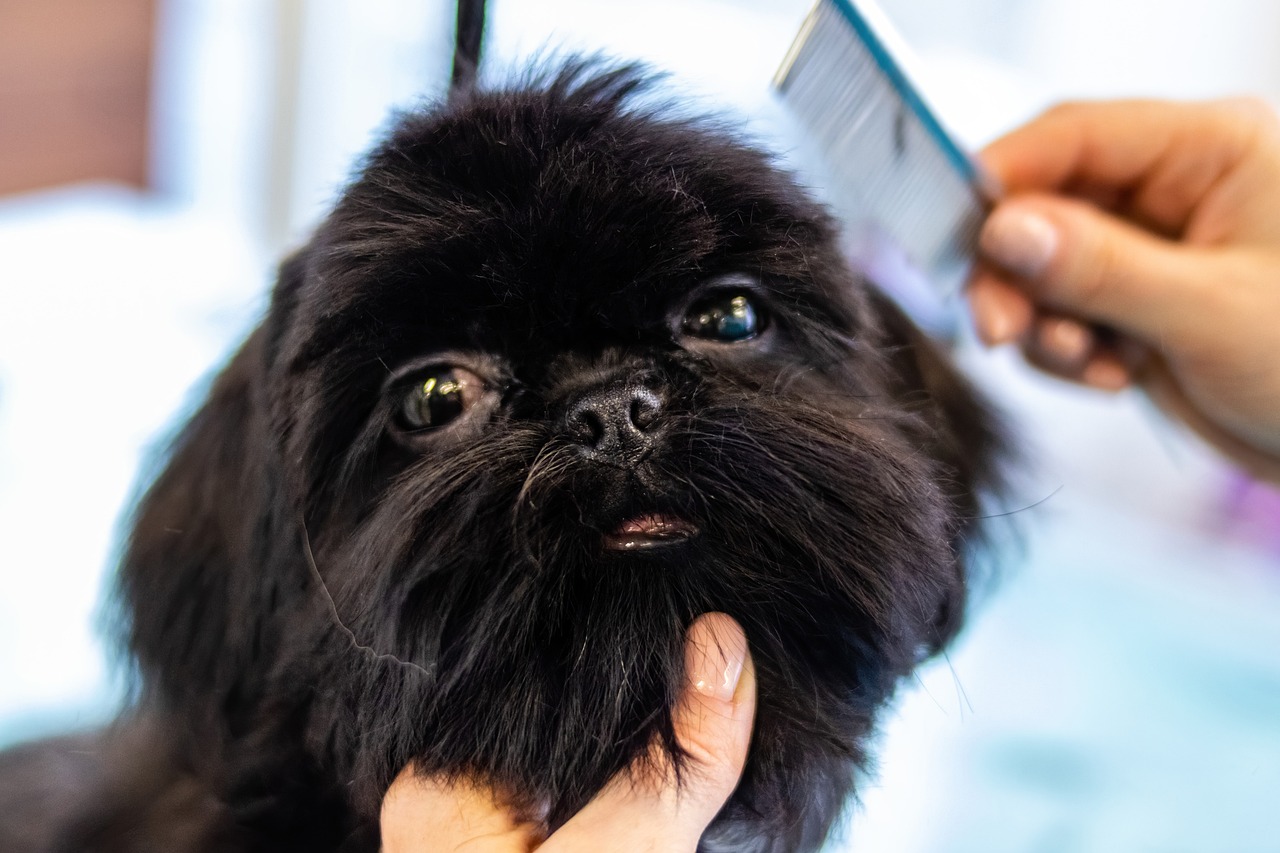
Preparing Your Pet for Grooming
When it comes to grooming your furry friend, preparation is key. Just like we might feel nervous before a big event, pets can also experience anxiety about grooming. The good news is that there are several effective strategies you can use to help your pet feel more comfortable and secure during these sessions. By taking the time to prepare, you can transform grooming from a stressful ordeal into a calm and positive experience for both you and your pet.
One of the first steps in preparing your pet for grooming is to acclimate them to the grooming environment. This means introducing them to the sights, sounds, and smells associated with grooming in a gradual manner. For instance, you might want to start by allowing your pet to explore the grooming area while it’s not in use. Let them sniff around and get familiar with the equipment, such as brushes and clippers. This can help reduce their fear of the unknown when it’s time for the actual grooming session.
Additionally, consider using desensitization techniques to ease your pet into the grooming process. This can be as simple as gently brushing your pet for short periods at home, gradually increasing the duration as they become more accustomed to the sensation. You can also introduce grooming tools one at a time, allowing your pet to investigate them at their own pace. Over time, these small steps can significantly reduce your pet's anxiety.
Creating a positive environment is also essential. A calm atmosphere can do wonders for your pet’s mental state. Try playing some soothing music or using familiar scents that your pet loves, such as their favorite blanket or a calming spray designed for pets. You might be surprised at how much these small changes can help your pet relax. Remember, a little comfort goes a long way!
In addition to these strategies, it’s crucial to reward your pet throughout the grooming process. Positive reinforcement can change the way your pet perceives grooming. After each grooming session, offer treats, praise, or playtime to create a positive association with the experience. This not only helps them feel more at ease but also encourages good behavior during future grooming sessions.
Lastly, if your pet continues to show signs of anxiety despite your best efforts, consider consulting a professional groomer or a veterinarian. They can provide additional insights and techniques tailored specifically to your pet's needs. Remember, the goal is to create a stress-free grooming experience that fosters trust and comfort between you and your beloved pet.
- How can I tell if my pet is anxious during grooming? Look for signs such as trembling, hiding, excessive vocalizations, or aggressive behavior. These are indicators that your pet may be feeling stressed.
- What are some desensitization techniques I can use? Gradually expose your pet to grooming tools and sessions, starting with short periods of brushing or handling. Increase the duration as they become more comfortable.
- Is it better to groom my pet at home or take them to a professional? It depends on your pet's comfort level. Some pets do better at home where they feel secure, while others may benefit from the expertise of a professional groomer.
- What should I look for in a groomer? Choose a groomer who has experience with anxious pets, is patient, and is willing to discuss their approach to handling grooming anxiety.
Desensitization Techniques
Desensitization techniques are crucial in helping your pet overcome grooming anxiety. Think of it as a gentle introduction to the grooming world, where the goal is to make the experience as stress-free as possible. Just like humans can develop phobias, pets can also become fearful of specific situations, such as being groomed. The process of desensitization involves gradually exposing your pet to grooming tools and environments in a controlled and positive manner.
To start, you can introduce grooming tools when your pet is relaxed and in a familiar environment. For instance, let your pet sniff and explore the brush or clippers without any grooming taking place. This initial exposure helps create a positive association with the tools. You might sit on the floor with your pet, allowing them to investigate at their own pace. This is akin to introducing a child to a new toy—it's all about making it fun and non-threatening.
Once your pet seems comfortable with the tools, you can proceed to simulate grooming without actually doing it. For example, gently run the brush over their fur for just a few seconds, followed by a treat or praise. This technique is effective because it pairs the potentially scary experience with something positive, reinforcing the idea that grooming isn’t something to fear.
As your pet grows more accustomed to the sensations, you can gradually increase the duration and intensity of the grooming simulation. Over time, you can introduce actual grooming sessions, but remember to keep them short and sweet at first. It’s crucial to monitor your pet’s body language throughout this process. If they show signs of discomfort, such as tensing up or trying to escape, it’s a signal to take a step back and slow down. Desensitization is all about patience and understanding.
Incorporating positive reinforcement is key. Every time your pet remains calm during a grooming session, reward them with treats or their favorite toy. This not only encourages good behavior but also builds a positive association with grooming. Over time, your pet will learn that grooming can be a pleasant experience, rather than something to dread.
Additionally, consider using calming aids such as pheromone sprays or soothing music to create a relaxing atmosphere during grooming sessions. These elements can help further reduce anxiety, making the desensitization process more effective. Remember, the goal is to make grooming a bonding experience rather than a battle. With consistency, love, and patience, you can help your furry friend overcome their grooming anxiety.
- How long does the desensitization process take? The duration varies by pet. Some may adapt quickly, while others might need weeks or even months. Patience is essential.
- Can I use treats during the process? Absolutely! Treats are a fantastic way to create positive associations and encourage calm behavior.
- What if my pet still shows anxiety after desensitization? If anxiety persists, consider consulting a professional groomer or a veterinarian for additional strategies or support.
- Is desensitization only for grooming? No, desensitization can be applied to various situations where pets may feel anxious, such as vet visits or loud noises.
Creating a Positive Environment
Establishing a positive grooming environment is pivotal in easing your pet's anxiety. Think of it as setting the stage for a performance; if the atmosphere is right, your pet is more likely to shine rather than shy away. Start by choosing a quiet space where your furry friend feels safe and comfortable. This could be a familiar room in your home or a designated area in the groomer's salon that’s away from the hustle and bustle. The goal is to create a sanctuary where your pet can relax.
Next, consider the use of soothing music. Just like humans, pets can benefit from calming sounds. Soft instrumental music or nature sounds can help drown out stressful noises and create a serene ambiance. You might be surprised at how much a gentle melody can transform the mood during grooming sessions. Additionally, incorporating familiar scents, such as your pet's favorite blanket or a calming essential oil, can provide a sense of security. Just be cautious with the oils; not all are pet-safe, so do your research beforehand!
Moreover, positive reinforcement plays a crucial role in building a comforting environment. Use treats, praise, and gentle petting to reward calm behavior before, during, and after grooming. This not only distracts your pet from their anxiety but also helps them associate grooming with positive experiences. Imagine how much easier it would be for your pet to relax if they knew that grooming meant treats and cuddles!
Another effective strategy is to introduce grooming tools gradually. Instead of jumping right into the grooming session, allow your pet to explore the tools first. Let them sniff the brush or the clippers while you offer treats and praise. This gradual introduction can demystify the tools and make them less intimidating. It’s like showing a child a new toy before letting them play with it; familiarity breeds comfort.
Lastly, ensure that the grooming process is tailored to your pet's needs. Every pet is different, and understanding their individual preferences can make a world of difference. Some pets may prefer a slower pace, while others might thrive on a more energetic approach. Pay attention to your pet's cues and adjust your grooming style accordingly. By creating a personalized grooming experience, you not only reduce anxiety but also strengthen the bond between you and your furry companion.
- What should I do if my pet continues to show signs of anxiety during grooming?
If your pet shows persistent signs of anxiety, consider consulting a professional trainer or a veterinarian who specializes in animal behavior. They can provide tailored strategies to help your pet cope.
- How often should I groom my pet?
The frequency of grooming depends on your pet's breed and coat type. Generally, long-haired breeds require more frequent grooming than short-haired ones. Consult your vet or groomer for specific recommendations.
- Can I use calming products to help with grooming anxiety?
Yes, there are various calming products available, including pheromone sprays, calming collars, and anxiety wraps. Always check with your veterinarian before trying new products to ensure they are safe for your pet.
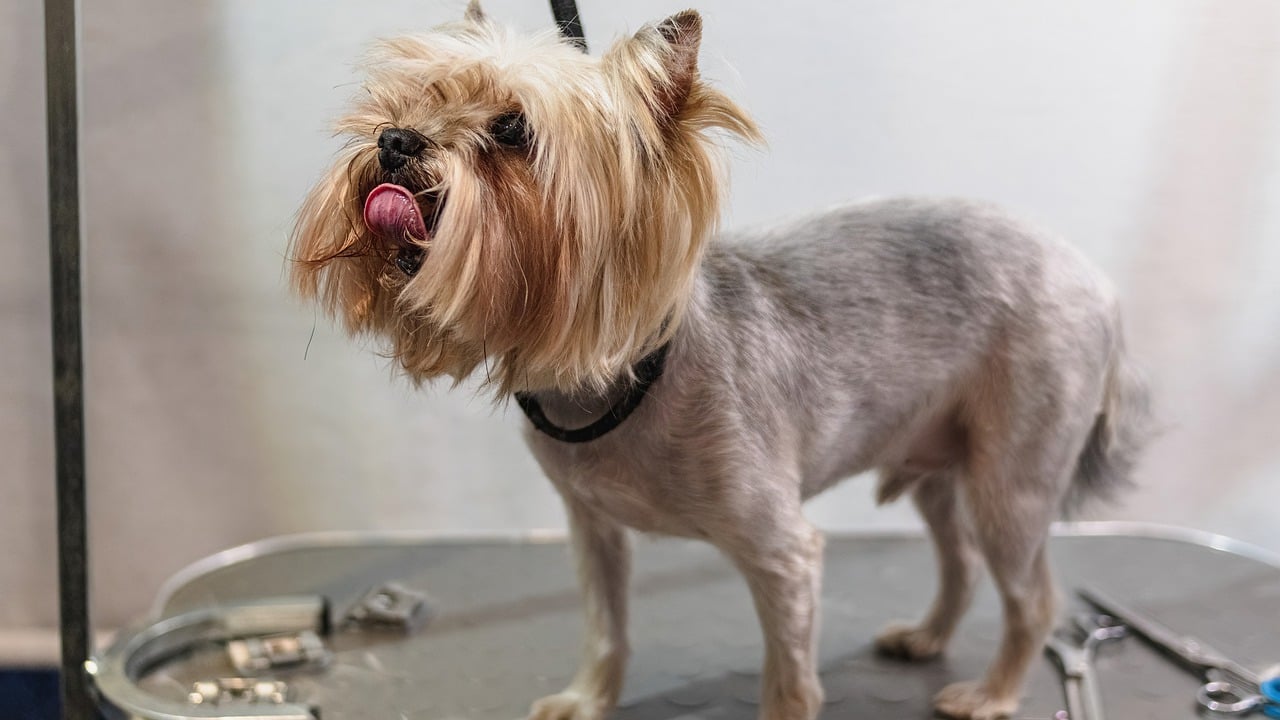
Choosing the Right Groomer
Choosing the right groomer for your furry friend is a crucial step in ensuring a positive grooming experience, especially if your pet struggles with anxiety. It's not just about finding someone who can make your pet look fabulous; it's about finding a professional who understands the unique needs of anxious pets. Think of it like finding a good doctor for yourself—it's essential to feel comfortable and trust the person handling your care. So, how do you go about selecting the perfect groomer? Let’s dive into some important considerations.
First off, experience matters. You want to find a groomer who has a solid background in handling pets with anxiety. Ask about their experience with nervous animals and their approach to calming them during grooming sessions. A groomer who is patient and gentle can make all the difference in your pet's comfort level. You might even want to visit the grooming salon beforehand to observe how the staff interacts with the animals. Do they seem calm and confident? Are the pets in their care relaxed? These observations can provide valuable insights.
Next, communication is key. Don’t hesitate to have a conversation with potential groomers about your pet's specific anxiety issues. A good groomer will be open to discussing your concerns and may even have strategies in place to help ease your pet’s anxiety. For example, they might use calming techniques or take extra time to build trust with your pet before the grooming process begins. Remember, you know your pet best, so sharing their triggers and fears can help the groomer tailor their approach.
Additionally, consider the environment of the grooming facility. A chaotic or noisy environment can heighten anxiety levels in pets. Look for a groomer who maintains a calm atmosphere, perhaps with soothing music or a quiet waiting area. Some groomers even have separate spaces for anxious pets, allowing them to feel more secure. You want your pet to associate grooming with a sense of safety rather than fear.
Lastly, don't forget to ask for references or read reviews from other pet owners. Hearing about others' experiences can provide reassurance or raise red flags. Look for comments on how the groomer handled anxious pets and whether they seemed to prioritize the animals' comfort. If possible, seek recommendations from friends or family who have pets with similar grooming needs.
In summary, finding the right groomer involves a mix of research, observation, and communication. By prioritizing your pet's comfort and well-being, you're setting the stage for a much more positive grooming experience. Remember, it's all about creating a partnership between you, your pet, and the groomer to ensure that grooming is a stress-free and even enjoyable experience for everyone involved.
- How do I know if my pet is anxious about grooming? Look for signs like trembling, hiding, or excessive vocalizations. Understanding these indicators helps you address your pet's discomfort effectively.
- Can I groom my pet at home instead? Yes, home grooming can be a great option for pets that experience anxiety. It allows you to control the environment and pace, making it less stressful for your furry friend.
- What should I ask a groomer before choosing them? Inquire about their experience with anxious pets, their grooming techniques, and how they create a calming environment.
- Are there specific grooming tools that help reduce anxiety? Yes, tools designed for sensitive pets, such as gentle brushes and calming sprays, can help make the grooming process smoother.
Questions to Ask Groomers
When it comes to finding the right groomer for your pet, asking the right questions can make all the difference. You want to ensure that the groomer not only understands pet grooming but also has a compassionate approach to handling anxious animals. Start by inquiring about their experience with pets that exhibit anxiety during grooming. For instance, you might ask, "How do you typically handle pets that show signs of fear or stress?" This question will help you gauge their level of understanding and their strategies for ensuring a calm experience.
Another important question to consider is, "What techniques do you use to desensitize anxious pets?" A good groomer should be familiar with various methods, such as gradual exposure to grooming tools or creating a soothing environment. Additionally, don’t hesitate to ask about their grooming philosophy. You could say, "How do you ensure that each pet feels safe and comfortable during the grooming process?" This will provide insight into their overall approach and whether it aligns with your expectations.
It’s also beneficial to inquire about the facilities themselves. Questions like, "What kind of environment do you provide for grooming?" can reveal whether the space is designed to minimize stress. Look for answers that mention calming music, familiar scents, or even separate areas for anxious pets. Furthermore, understanding the groomer's approach to breaks during grooming is crucial. You might ask, "Do you take breaks for pets that seem overwhelmed?" This shows that they are attentive to the needs of your furry friend.
Finally, don't forget to ask about the groomer's qualifications. Inquire about their training and certifications, such as, "What kind of training have you completed in handling anxious pets?" This will help you feel more confident in their abilities. Remember, the goal is to find a groomer who not only has the technical skills but also the empathy to make grooming a positive experience for your pet.
In summary, here are some key questions you should ask potential groomers:
- How do you handle pets that show signs of fear or stress?
- What techniques do you use to desensitize anxious pets?
- How do you ensure that each pet feels safe and comfortable during the grooming process?
- What kind of environment do you provide for grooming?
- Do you take breaks for pets that seem overwhelmed?
- What kind of training have you completed in handling anxious pets?
Grooming at Home
For many pet owners, grooming at home can be a game-changer. Not only does it save time and money, but it also allows you to create a comfortable and familiar environment for your furry friend. Imagine how much easier it is for your pet to relax when they're surrounded by their favorite toys and smells. However, home grooming comes with its own set of challenges, especially if your pet suffers from grooming anxiety. So, how can you make this experience as stress-free as possible?
First and foremost, it’s essential to gather the right tools. Having the proper grooming equipment can make all the difference. Here’s a quick rundown of what you might need:
- Brushes: Different types for different coat lengths and types.
- Shampoo: Choose one that is gentle and suitable for your pet's skin.
- Clippers: If your pet needs a haircut, invest in a quality clipper.
- Scissors: Great for trimming around sensitive areas.
Once you have your tools ready, it's time to set the stage. Create a grooming space that is quiet and free from distractions. You might want to play some calming music in the background or use a favorite blanket to make the area feel cozy. Remember, the goal is to make your pet feel safe and secure. You could even try to groom them while they are in their favorite spot, such as on the couch or in their bed.
Next, consider using positive reinforcement to help your pet associate grooming with good experiences. Treats, praise, and gentle petting can go a long way. For example, give your pet a treat every time they allow you to brush a certain area. This will help them to understand that grooming is not something to fear but rather a time for bonding and rewards.
Another effective strategy is to start small. If your pet is particularly anxious, begin with short grooming sessions. Focus on just one area, like brushing their back or trimming their nails, and gradually increase the duration as they become more comfortable. Think of it like building a muscle; the more you practice, the stronger it gets. Over time, your pet will start to look forward to these sessions.
Lastly, don't hesitate to seek help if needed. If you find that grooming at home is still a struggle, consider consulting a professional groomer for tips or even a trainer who specializes in anxious pets. You can also look into online resources or videos that demonstrate calming techniques and effective grooming practices.
Here are some common questions pet owners have when it comes to grooming anxiety:
- What should I do if my pet bites during grooming? - It's essential to stop immediately and assess the situation. You may need to take a break and try again later, or consult a professional trainer.
- How often should I groom my pet at home? - This depends on the breed and coat type. Generally, long-haired pets may need grooming every few days, while short-haired pets can be groomed weekly.
- Can I use human shampoo on my pet? - No, it’s best to use shampoos specifically designed for pets as their skin pH is different from ours.
Frequently Asked Questions
- What are the common signs of grooming anxiety in pets?
Grooming anxiety can manifest in various ways. Look for physical signs like trembling, hiding, or excessive barking. Additionally, behavioral changes such as aggression or withdrawal can indicate that your pet is feeling stressed. Vocalizations like whining or growling are also key indicators of anxiety during grooming sessions.
- How can I help my pet feel more comfortable with grooming?
Preparation is vital! Start by desensitizing your pet to grooming tools and environments. Gradually expose them to the grooming process, allowing them to investigate brushes or clippers without pressure. Creating a positive atmosphere with soothing music and familiar scents can also help ease their anxiety.
- Should I choose a professional groomer or groom my pet at home?
It depends on your pet's comfort level! Some pets may thrive with a professional groomer who understands anxiety, while others might feel more secure in their home environment. If you choose to groom at home, ensure you have the right tools and a calm setting to make the experience as stress-free as possible.
- What questions should I ask a potential groomer?
When selecting a groomer, inquire about their experience with anxious pets. Ask how they handle grooming stress and what techniques they use to calm pets. It’s also beneficial to understand their approach to desensitization and whether they offer a trial session to see how your pet reacts.
- Can desensitization really help with grooming anxiety?
Absolutely! Desensitization techniques involve gradually introducing your pet to grooming tools and processes in a stress-free manner. Over time, this can help them associate grooming with positive experiences, significantly reducing their anxiety during actual grooming sessions.

